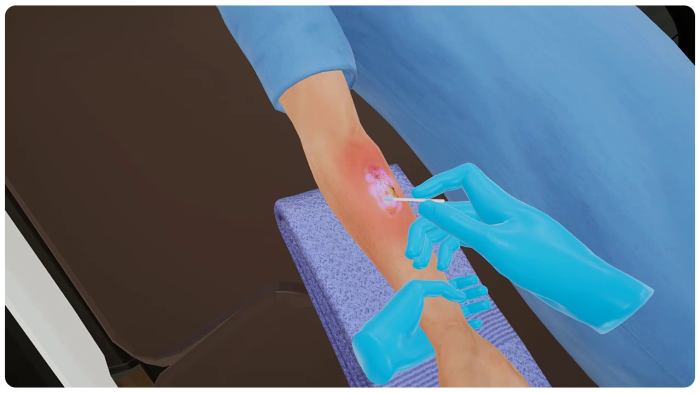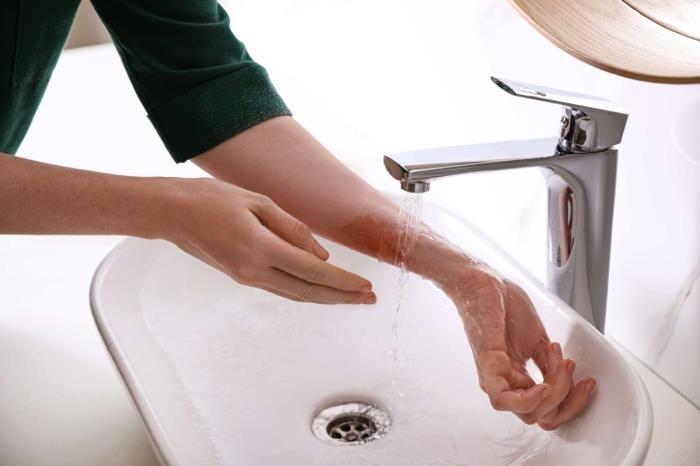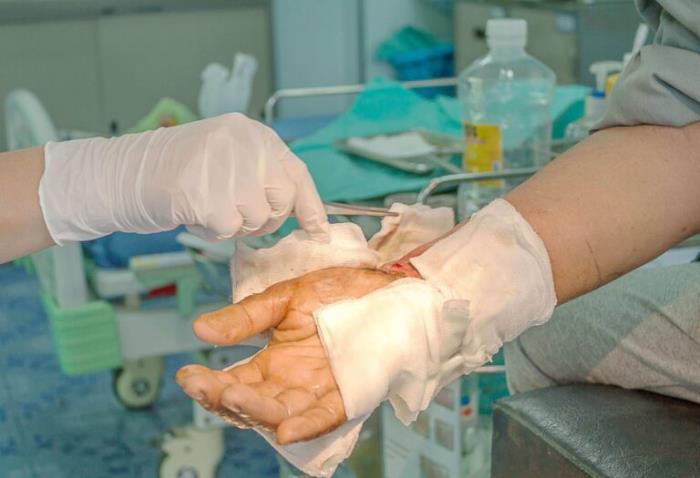Burn injuries occur when the skin or underlying tissues are damaged by heat, chemicals, electricity, or radiation. The severity of a burn is classified into first, second, or third-degree burns, depending on the depth of tissue damage. First-degree burns affect only the outer layer of the skin, while second-degree burns penetrate deeper into the dermis, and third-degree burns damage all layers, potentially reaching muscle or bone.
Medical disclaimer: This content is for general awareness and does not replace a doctor’s consultation. For diagnosis or treatment decisions, consult a qualified specialist.
Burn injuries can have profound physical and emotional effects on patients. Treatment varies depending on the burn’s severity and location, ranging from basic first aid to intensive medical care for deeper burns.
The Role of Wound Care in Burn Recovery
Proper wound care is essential in the recovery process for burn injuries. It helps prevent infection, promote faster healing, and minimize scarring. Depending on the type of burn, wound care can include cleaning, dressing changes, application of topical antibiotics, and monitoring for signs of infection.

For more severe burns, wound care may involve skin grafting or other surgical interventions to promote healing. Keeping the burn area clean and moisturized is also critical to ensure the skin regenerates healthily and reduces the risk of complications during recovery.
Types of Burns and How They Affect Wound Healing
Burns are categorized into three main types—first-degree, second-degree, and third degree—each with distinct effects on wound healing. First-degree burns, which affect only the outer skin layer, typically heal quickly within a few days without medical intervention. Second-degree burns affect the deeper layers of the skin and may require medical attention to prevent infection, usually healing within a few weeks.
Third-degree burns are the most severe, destroying both the epidermis and dermis, often requiring skin grafts for proper healing. Recovery from third-degree burns can be prolonged, and these burns often leave permanent scarring.
Immediate First Aid for Burn Wounds
Providing immediate first aid for burn wounds is crucial in minimizing damage and promoting healing. For minor burns, the affected area should be cooled with running water for 10-20 minutes to stop the burning process. After cooling, the wound should be covered with a clean, non-stick dressing or cloth.
For more severe burns, especially those involving large areas or third-degree burns, professional medical care is needed immediately. Do not apply ice, butter, or ointments to serious burns, as these can worsen the damage. Always remove any tight clothing or jewelry near the burn to allow for swelling.
The Stages of Burn Healing: What to Expect
Burn healing progresses through several stages, starting with the inflammatory phase, where the body’s immune response triggers redness, swelling, and warmth around the wound. This phase is followed by the proliferation phase, where new tissue and blood vessels form to cover the wound.
In the final stage, the remodeling phase, the wound contracts, and new skin strengthens over time. The duration of each phase depends on the severity of the burn, with first-degree burns healing in days, while more severe burns can take months to fully heal, potentially leaving scars or requiring ongoing care to maintain skin elasticity.
Why Proper Wound Cleaning Is Essential for Recovery
Proper wound cleaning is crucial in burn recovery to prevent infection and promote healing. Cleaning helps remove debris, bacteria, and dead tissue that can hinder the body’s natural healing processes. This essential step reduces the risk of complications and contributes to faster recovery with better long-term outcomes.
The Importance of Preventing Infection in Burn Wounds
Preventing infection in burn wounds is vital, as infections can lead to severe complications, delayed healing, and even life-threatening conditions like sepsis. Early intervention with antibiotics, proper wound cleaning, and sterile dressing applications are critical to minimizing infection risks and ensuring successful recovery.

Dressing and Bandaging Techniques for Burn Wounds
Appropriate dressing and bandaging techniques are key in burn wound care. Dressings protect the wound from contaminants, maintain a moist healing environment, and help manage pain. Different bandaging methods are used depending on burn severity to ensure optimal protection and promote skin regeneration.
How Moisture Management Helps in Burn Wound Healing
Maintaining a moist environment is essential in burn wound healing. It supports cellular repair, prevents scab formation, and helps promote tissue regeneration. This reduces pain and minimizes scarring, leading to improved healing outcomes.
The Role of Skin Grafting in Severe Burn Treatment
Skin grafting is vital for treating severe burns, especially when large areas of skin are damaged. The procedure involves transplanting healthy skin from another part of the body to cover the burn. Skin grafts protect the wound, reduce infection risk, and promote healing, making them a crucial solution for extensive injuries.

Pain Management Strategies During Wound Care
Pain management is an essential component of burn wound care. Strategies include the use of analgesics, local anesthetics, and non-pharmacological methods such as cooling the wound and applying proper dressings. Effective pain management not only improves patient comfort but also aids in healing by reducing stress on the body.
Nutrition and Its Impact on Burn Wound Healing
Proper nutrition is critical for burn wound healing, as the body requires increased nutrients to repair damaged tissue. A diet rich in protein, vitamins, and minerals supports skin regeneration, immune function, and overall recovery. Nutritional support is especially important for severe burns to ensure optimal healing.
Psychological Support in the Burn Recovery Process
Burn injuries can have a profound psychological impact, making emotional support a key component of recovery. Psychological counseling, support groups, and therapy help patients cope with trauma, body image changes, and emotional distress, fostering a holistic healing approach that addresses both physical and mental well-being.
The Importance of Regular Follow-ups in Burn Care
Regular follow-ups are essential in burn care to monitor healing progress, address complications, and adjust treatment plans. These check-ins allow healthcare providers to ensure proper wound healing, manage arising issues, and provide additional interventions when necessary for optimal recovery.
The Long-Term Effects of Burns on Skin Health
Burns can have lasting effects on skin health, including scarring, pigmentation changes, and reduced elasticity. In some cases, the skin may remain sensitive or more prone to injury. Long-term care, such as using moisturizers, sun protection, and possible surgical interventions, helps manage these outcomes and improve skin function over time.
Dealing with Scars: Post-Burn Wound Care
Post-burn wound care often focuses on minimizing scarring. Scar management techniques include using silicone sheets, pressure garments, and moisturizing treatments to reduce scar formation. In some cases, laser therapy or surgical interventions may be recommended to improve the appearance and flexibility of scar tissue, promoting better long-term skin health.
How to Choose the Right Burn Care Specialist
Choosing the right burn care specialist is crucial for effective treatment and recovery. Look for a professional with experience in treating burn wounds, particularly in complex or severe cases. Specialists affiliated with burn centers or hospitals offering comprehensive care, including surgical, rehabilitation, and psychological services, are ideal for managing recovery.
Innovations in Burn Wound Care Treatments
Recent innovations in burn wound care have significantly improved recovery outcomes for patients. Advancements include bioengineered skin substitutes, advanced wound dressings that promote faster healing, and the use of stem cell therapies. These innovations aim to reduce healing time, minimize scarring, and enhance overall recovery for burn patients.
Tips for At-Home Wound Care After Hospital Discharge
Proper at-home wound care is essential for continuing the healing process after hospital discharge. Patients should follow their healthcare provider’s instructions, including cleaning and dressing the wound, managing pain, and monitoring for signs of infection. Regular moisturizing, avoiding sun exposure, and adhering to prescribed physical therapy can also aid in recovery.
The Role of Occupational Therapy in Burn Recovery
Explore how occupational therapy plays a vital role in helping burn survivors regain function and independence. Through tailored rehabilitation programs, occupational therapists assist patients in improving their daily living skills and coping with emotional challenges post-injury.
Innovative Dressings and Their Benefits for Burns
Learn about innovative dressings designed specifically for burn treatment, including hydrocolloid and silver-infused dressings. These advanced materials enhance healing, reduce pain, and minimize infection risk, providing better care for burn wounds.
Best Severe Burn Treatment in India
The Best Severe Burn Treatment in India is delivered by specialized burn surgeons who use advanced techniques to promote healing and recovery, providing personalized care tailored to each patient's unique needs.
Best Severe Burn Hospitals in India
The Best Severe Burn Hospitals in India are equipped with state-of-the-art facilities and technology, ensuring comprehensive care, including pre-treatment evaluations and post-operative rehabilitation for optimal recovery.
Severe Burn Treatment Cost in India
When evaluating the Severe Burn Treatment Cost in India, patients can expect competitive pricing at top hospitals, which offer transparent costs without sacrificing the quality of treatment and care.
Best Severe Burn Doctors in India
The Best Severe Burn Doctors in India possess extensive experience in burn management, focusing on individualized care and innovative surgical techniques to enhance recovery and improve patient outcomes.
FAQs About Wound Care in Burn Recovery
What should I do if my burn wound becomes infected?
If you notice signs of infection, such as increased redness, swelling, or pus, seek medical attention immediately. These symptoms could delay healing and lead to further complications.
How long will it take for my burn wound to heal?
Healing times vary based on the severity of the burn. Minor burns may heal in a few weeks, while more severe burns can take months and may require ongoing care.
Can I speed up my wound’s recovery process?
Following medical advice, maintaining proper wound care, staying hydrated, and eating a nutritious diet can help optimize healing and reduce recovery time.
What is the best way to prevent scarring?
Use silicone gels or sheets, keep the wound moist, and follow your doctor's recommendations for compression therapy and other treatments aimed at reducing scars.
Are there any activities I should avoid during my recovery?
Avoid strenuous activities or movements that could stress the wound. Also, avoid direct sunlight exposure, which may worsen scarring or slow the healing process.